Mostly, the funeral ceremonies (Rambu Solo) in Toraja are held in July - August , a period of agricultural quiet when people have harvested the rice paddies, which also coincides with children's school vacation although it may happen any time of the year. Family members from all over the country will come home to join the ceremony.
Preparations are made by first discussing what kind of ceremony is going to be held, when and where. Then they have to divide tasks. After that they will have to find a ceremonial side and prepare all that is needed : supplies to build lantang (huts) and lakkian (a high barn for the coffin). All is done with the help of families and other villagers. The ceremonial side (usually called rante) is a rectangular area with a small entrance. The lantang and lakkian are build around an empty field for buffaloes slaughtering.

We arrived at Tikkala, about 3 km north of Rantepao at 8.15 a.m. Our guide said, the deceased died three years ago. It was the third day of the ceremony and the second day of **Mantaa Padang. There were horns of the previous day's sacrificed buffaloes tied on a pole in the middle of the field. To watch a funeral, we better wear dark clothing. We waited until we were invited inside. To show respect, we gave a pack of cigarettes to the person inviting us into his lantang. The cigarettes cost us US$ 9.
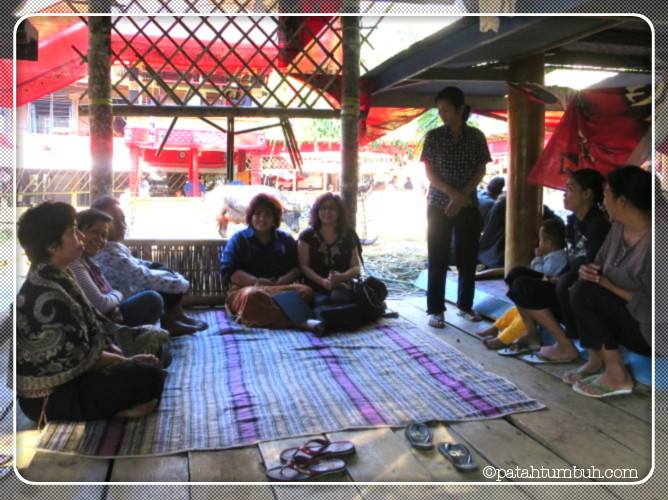

There are four classes of ceremony for the deceased based on the socio-economy level of the family:
- For the slaves (tana’ kua-kua, the lowest caste) - Slavery was prohibited since more than a century ago.
- Dipasilamun tallo' manuk - still born babies were buried the same day with chicken egg and the placenta, hence also called dipasilamun toninna (toni means placenta).
- Didedekan Palungan or Dikambuturan Padang - poor adults were buried the same day after a ritual of banging the bowls of pigs’ food or feet tapping.
- Disilli - babies with no teeth yet were buried in a hole inside a live tree trunk.
- Dibai Tungga - at least one pig was needed for this kind of funeral ceremony. It was done in one night and the corpse was buried the next day.
- Dibai A’pa - four to ten pigs were sacrificed and the corpse was buried the next day.
- For free people (tana’ karurung)
- Diisi - When a noble’s child died before teething, a buffalo is sacrificed.
- Dipasangbongi (ditedong tungga) - One buffalo and at least four pigs are needed. *Ma’badong is performed and the corpse is buried the next day.
- Dipatullung Bongi - Three to five buffaloes and a minimum of 16 pigs are sacrificed. The corpse is buried after three nights.
- For middle class aristocrats (tana’ bassi)
- Dipalimang Bongi - At least five buffaloes and the minimum of 18 pigs are required. It is done in five days.
- Dipapitung Bongi - A minimum of seven buffaloes and 22 pigs are required for this kind of ceremony. It is done in seven nights.
- For high class nobles (tana’ bulaan)
Dirapa’i is the most expensive and done only by nobles or the rich and powerful. A statue (tau-tau) is made for the deceased and a simbuang batu (megalith) is erected in the middle of rante to pay respect and for the soul to stay.
- Rapasan Dilayu-layu - At least nine buffaloes and 32 pigs are sacrificed for this ceremony.
- Rapasan Sundun - 24 buffaloes and 32 pigs are the minimum.
- Rapasan Sapu Randanan - A minimum of 30 buffaloes and 32 pigs is required for this top level of Rambu Solo.
*Wives get more buffaloes sacrificed than their husband, because Torajans believe women are to be respected more than men.
*Ma’ Badong is a ritual where people dance and sing sad songs (kadong badong) at the front yard of tongkonan about life.
There are two parts of Dirapa’i ceremony:
- Dialuk Pia / Dialuk Banua
- Dialuk Palao / Dialuk Rante
Dialuk Pia goes on for four days in a row:
- Dipakalambi’i - Changing the corpse position to face south. Family members and close relatives begin to wear black clothes and stop eating rice (food related with happiness) and eat corn or sweet potatoes (food related with sadness) instead. This practice is called maro’ and is obeyed until all the ceremonies are completed. Buffaloes and pigs are sacrificed and through-the-night Ma’Badong is perfomed.
- Welcoming families and distant relatives coming with gifts and Ma’ Badong. The gifts are to be paid back when the giver organizes the same ceremony.
- Two rituals are performed the third day - Ma’ Bolong - pig slaughter in the morning by to mebalun (the coordinator of the ceremony), followed by Ma’ Batang, buffalo sacrifice at the ceremony field (rante) and prayers chanting for the ancestors from above the bala’kayan (a high stage built for handing out sacrificed meat inside a rante).
- Putting the wrapped corpse inside a coffin made of kayu mate (dead wood).
Dialuk Palao goes on in this order:
1. Ma’ Palao - The coffin is paraded to rante to be put inside a lakkian (a barn in rante especially built high to put the coffin before it is buried). Buffaloes fights (ma’ pasilaga tedong) take place later this day to find the strongest buffalo. A buffalo is then killed and the meat is shared.
From Tikkala, we went to Ba'lele, 1 km from Rantepao to watch Ma' Palao. This time we brought with us four dollars worth of sugar. I wouldn't mind give more though, considering how much they spent for this kind of ceremony and it really is very kind of them to let us foreigners witness their considered sacred rituals. The deceased died quite young at the age of 50 gored by an angry buffalo at a buffalo fight.
The coffin is paraded around rante with songs and prayers. The parade is led by two men carrying a big gong, followed by tompi saratu (flag bearer), tedong (buffaloes), lamba-lamba ( a long red cloth carried by women of the house ) and at the end of the procession is duba-duba (casket) carried with saringa (palanquin) made of bamboo.

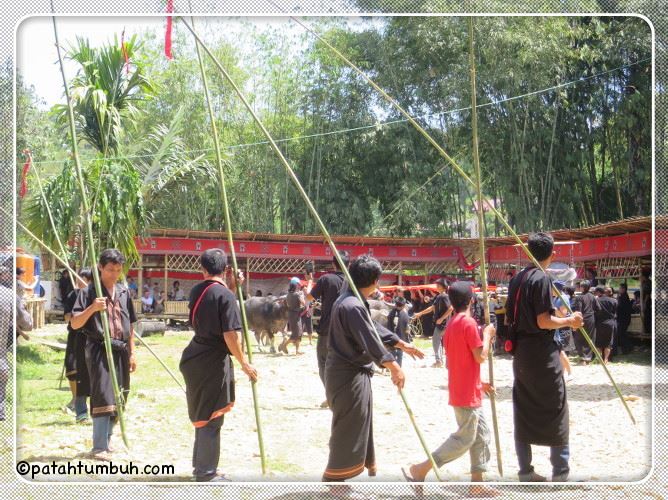
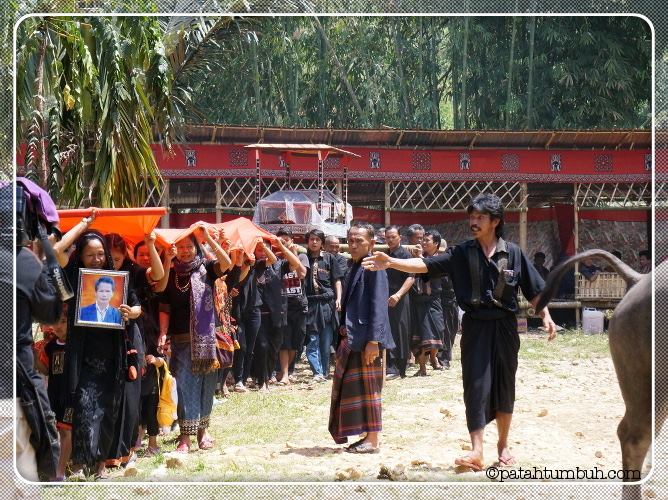
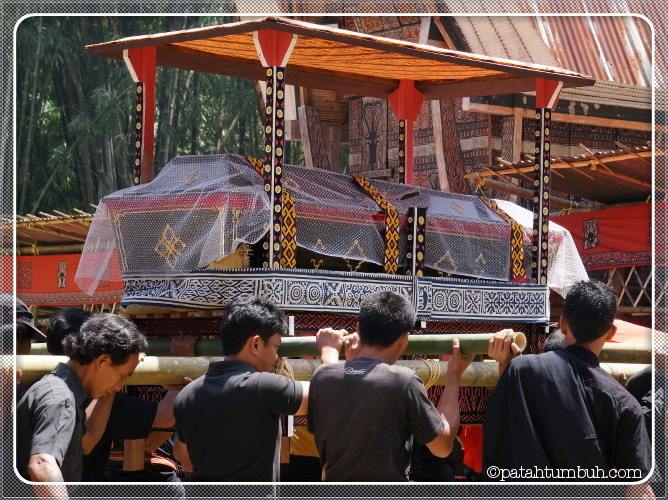

Later that day they will have buffaloes fight which is itself a very much awaited event by the Torajan people. Unfortunately, many make it a gambling opportunity that it loses its original purpose.

2. Karampoan Tau - Guests are welcomed and guided to the temporary lantang at the right side of lakkian ten by ten. Everything is documented : who brings what and how many, the value of the animals brought, for whom are those animals (It might be for the deceased, the deceased’s son, wife or whoever in the family), and for what are the animals (It might be a gift, a loan, or an old debt payment). When all guests have arrived, they will be called according to their caste and appointed the number of lantang at the left side of the lakkian where they are going to stay for the rest of the ritual (might be days or weeks).

I was standing at this exact corner to get a better angled shot of a **ma'tinggoro tedong, and then the hurt buffalo went amok and charged to our corner. Luckily I had expected this and jumped right up into the lantang behind me. An experience I will never forget for the rest of my life!
3. Allo katorroan - Families and elders discuss what to do next, how many of the buffaloes are to be slaughtered and what to do to the rest (might be kept or given to the church or the poor)
4. *Mantaa padang - Buffaloes slaying and meat sharing. The ritual begins with prayers led by the priest and speech by the family of the deceased. The buffalo is killed in one smooth cut (called **ma'tinggoro tedong).

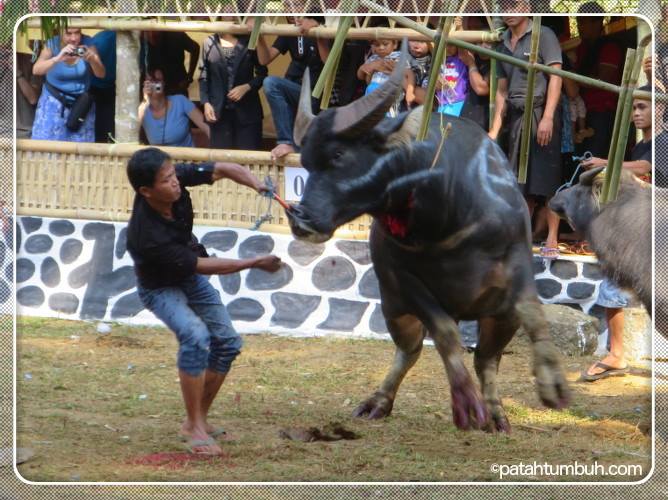
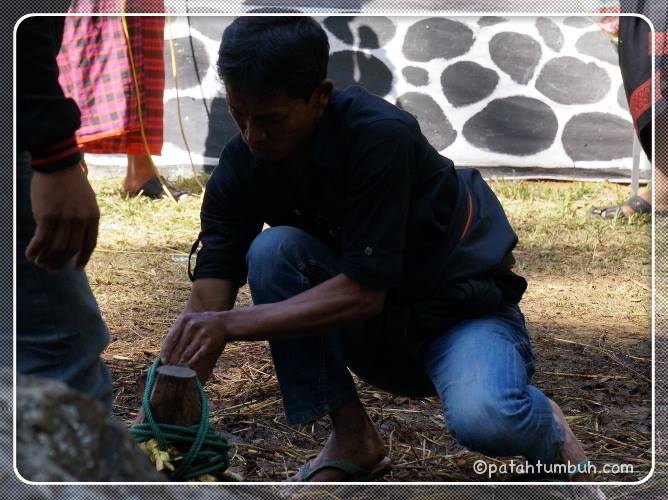
Later after all the buffaloes are killed, the meat is shared from above the bala'kayan.
4. Meaa - The coffin is then taken to the burial site and buried.
Nowadays, some Torajan families choose to have modern funeral with less and less sacrificed animal, yet, just in 2013 there was a ceremony held with one hundred buffaloes sacrificed!
Previous: Tana Toraja, Where the Living Live for the Dead - I
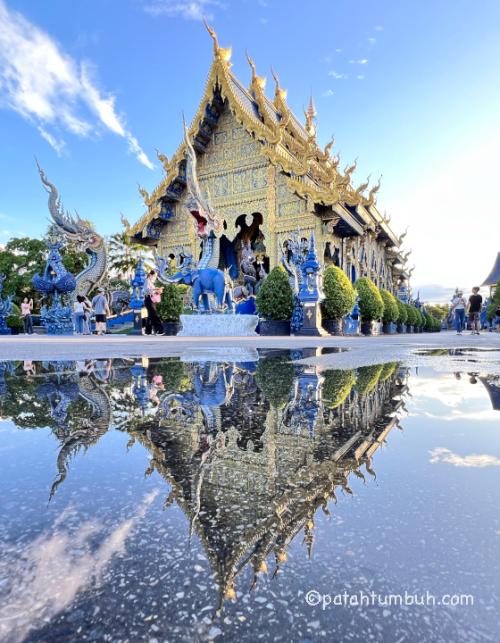

Add new comment